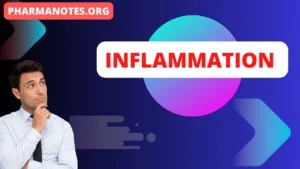Inflammation

Objective
At the end of this PDF, student will be able to
• Define “inflammation”
• Classify inflammation
• Describe the etiology of inflammation
• Identify the signs of inflammation
• Describe the changes involved in acute inflammation
Inflammation
“Local response of living mammalian tissues to injury due to any agent “
• Body defence reaction to eliminate or limit the spread of injurious agent, followed by removal of the necrosed cells and tissues
• Protective response
Etiology of Inflammation
• Infective agents – bacteria, viruses and their toxins, fungi, parasites
• Immunological agents – cell-mediated and antigen antibody reactions
• Physical agents – heat, cold, radiation, mechanical trauma
• Chemical agents – organic and inorganic poisons
Signs of inflammation
4 cardinal signs of inflammation
• Rubor (redness)
• Tumor (swelling)
• Calor (heat) and
• Dolor (pain)
Fifth sign – functio laesa (loss of function) – Virchow
Types of inflammation
Depending upon the defense capacity of host and duration of response
• Acute Inflammation
• Chronic inflammation
Acute Inflammation
• Short duration
• Represents early body reaction
• Followed by repair
Main features
• Accumulation of fluid & plasma at the affected site
• Intravascular activation of platelets
• Polymorpho nuclear neutrophills (PMN) – inflammatory cells
Chronic Inflammation
• Longer duration
• If causative agent of acute inflammation persists for long periods
• Recurrent attack of acute inflammation
Main features:
• Presence of lymphocytes, plasma cells & Macrophages as inflammatory cells
Changes in Acute inflammation
Two main events involved
1. Vascular events
• Alteration of microvasculature (arteries, capillaries & venules)
2. Cellular events
• Exudation of leucocytes
• Phagocytosis
Vascular events
• Alteration in the microvasculature – tissue injury
Haemodynamic Changes
Earliest features – vascular flow change, calibre of small blood vessels
1. Irrespective of the type of injury – transient vasoconstriction of arterioles
• Mild form – blood flow – 3-5 seconds
• More severe injury the vasoconstriction – 5 minutes
Vascular changes
2. Persistent progressive vasodilatation
• Mainly arterioles
• lesser extent – venules and capillaries
• Increased blood volume – redness and warmth
3. Progressive vasodilatation
• Elevate the local hydrostatic pressure – transudation of fluid into the extracellular space – swelling
4. Stasis of microcirculation
• Increased concentration of red cells – blood viscosity
5. Leucocytic margination
• Leucocytes stick to the vascular endothelium
• Move and migrate through the gaps between the endothelial cells into the extravascular space
• Emigration
Triple response
Flush
– Appearance of red line
– Local vasodilatation of capillaries and venules
Flare
– Bright reddish appearance or flush surrounding the red line
– Vasodilatation of the adjacent arterioles
Wheal
– Swelling or oedema of the surrounding
– Transudation of fluid into the extravascular space
Pathogenesis of altered vascular permeability
Normal circumstances – fluid balance – two opposing sets of forces that causes:
Outward movement of fluid from microcirculation
– intravascular hydrostatic pressure
– colloid osmotic pressure of interstitial fluid
Inward movement of interstitial fluid into circulation
– intravascular colloid osmotic pressure
– hydrostatic pressure of interstitial fluid
Contraction of endothelial cells
• Increased leakiness – venules exclusively
• Endothelial cells – temporary gaps – contraction – vascular leakiness – release of histamine, bradykinin and others
• Response – immediately after injury – reversible – short duration (15-30 minutes)
• Example: immediate transient leakage is mild thermal injury of skin of forearm
Retraction of endothelial cells
• structural re-organisation of the cytoskeleton of endothelial cells – reversible retraction – intercellular junctions – venules – cytokines such as interleukin-1 (IL-1) and tumour necrosis factor (TNF)-α – response takes 4-6 hours after injury – lasts for 2-4 hours or more
• The example invitro experimental work only
Direct injury to endothelial cells
• Cell necrosis, physical gaps at the sites of detached endothelial cell – thrombosis at site initiated
• Affects – microvasculature – immediately after injury last for several hours or days or delay of 2-12 hours and last for hours or days
Summary
• Inflammation is the local response of living mammalian tissues to injury due to any agent
• The four cardinal signs of inflammation are redness, swelling, heat and pain
• Inflammation is of 2 type acute and chronic inflammation
• Acute inflammation is of Shorter duration , represents early body reaction, followed by repair
• Chronic inflammation is of longer duration and occurs when the agents remains for longer time
• Acute inflammation is characterized by cellular events and vascular events
FAQ:
Q1: What is inflammation, and how is it defined? Inflammation is a complex biological response of the body to harmful stimuli, such as pathogens, injury, or irritants. It is characterized by specific physiological changes and can be either acute or chronic.
Q2: How is inflammation classified? Inflammation is classified into two main types: acute inflammation, which is a short-term and immediate response, and chronic inflammation, which is a prolonged, sustained reaction often associated with tissue damage.
Q3: What is the etiology of inflammation? Inflammation can be triggered by various factors, including infections, physical injuries, chemical irritants, autoimmune disorders, and exposure to foreign materials or allergens.
Q4: What are the signs of inflammation that can be observed? Common signs of inflammation include redness (erythema), heat (calor), swelling (tumor), pain (dolor), and loss of function (functio laesa). These are often referred to as the five cardinal signs of inflammation.
Q5: Could you describe the changes involved in acute inflammation? Acute inflammation is characterized by rapid and short-term changes, including dilation of blood vessels (vasodilation), increased vascular permeability, recruitment of immune cells like neutrophils, and the release of various chemical mediators. These changes collectively help the body respond to and eliminate the source of injury or infection.



